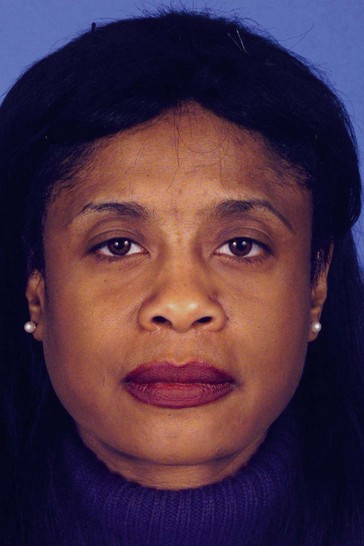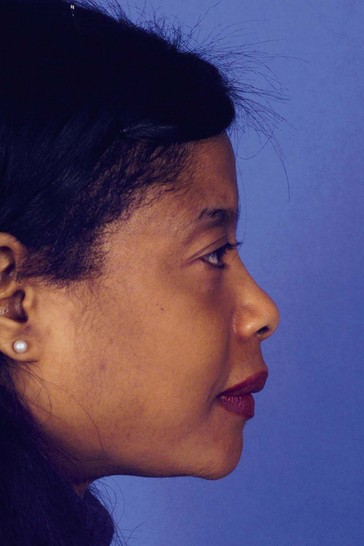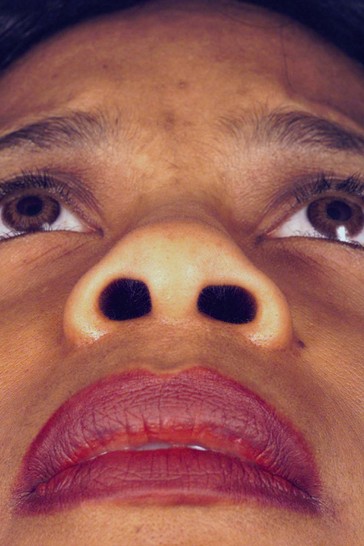Chapter 18 Rhinoplasty and Ethnicity
Online Contents
In this Chapter Online at experconsult.com
Rhinoplasty in the African–American nose Animation 18.1
Rhinoplasty in the Asian Nose Animation 18.2
Pearls
• The African-American face has distinct characteristics such as prominent forehead, prominent malar bones, wider bi-malar distance, prominent lips, and, often, microgenia that have to be taken into consideration in planning the rhinoplasty.
• The African-American nose is often wide, flat with short nasal bones, has an underprojected wide tip, wide alar bases, thin lower lateral cartilages, a low radix, small hump, and deficient subnasale.
• Since the nasal bones are short in African-American noses, they may not heal consistently in the optimal position and may shift laterally as time elapses.
• Narrowing of the alar base in African-American noses may require removal of skin from the nostril sill area, even if the sill is ill-defined or absent.
• Asian patients have a receding mid-face, prominent lips, prominent and wide malar bones, and microgenia.
• Asian noses have wide nasal bones, wide and thin lower lateral cartilages, a wide tip, a wide base, low radix, minimal or no hump, inadequate tip projection, deficient subnasale, short and wide horizontally oriented nostrils, and footplates that are displaced laterally.
• Available septal cartilage on both Asian and African-American noses is limited and one has to be prepared to harvest conchal or costal cartilage graft, especially for secondary rhinoplasty.
• The specific maneuvers required for correction of the Asian nose include a more common need for dorsal augmentation, tip graft, use of a columella strut, elongation of the nose, reorientation of the nostril, and removal of the redundant portion of the soft triangle lining.
• Many Middle Eastern patients have some degree of dorsal deviation which often becomes more obvious after removal of the dorsal hump.
• The intercanthal distance in Middle Eastern noses is usually narrower and augmentation of the radix, if necessary, should be done conservatively.
• Middle Eastern patients commonly have long nasal bones, a narrow vault, long upper lateral cartilages, hanging tip, base asymmetry, low radix, large hump, inadequate tip projection, hanging columella, and deficient anterior nasal spine.
• Since the tip is very dependent on the dorsum on patients of Middle Eastern descent, as the hump is reduced, the tip projection will be significantly diminished.
• One key step in achieving sufficient improvement and an optimal and lasting outcome on Middle Eastern noses is cephalic rotation of the tip and fixation in new position using a non-absorbable suture.
• Additionally, correction of Middle Eastern noses will require spreader grafts, columella strut and weakening of the depressor nasi septi muscle.
Facial ethnicity is defined by the color of the skin, along with the length, width, and projection of the different segments of the face. Regardless of ethnicity, the attractiveness of the face is governed by the harmony between the different zones.1,2 This includes the nose. Additionally, there has to be an equilibrium between the different units of the nose in order for it to look pleasing. In this chapter, we will focus on three common ethnic noses and describe the physical attributes and the changes that would create a better balance between the nose and the rest of the face for each ethnic group.
African-American Nose
Analysis
On a frontal view of the nose, one often finds a wide nose with short nasal bones, wide lower lateral cartilages, a wide tip, thin and often convex lower lateral cartilages, and a wide alar base, often without a well-defined nostril sill (Box 18.1; Figure 18.1).

Figure 18.1 Front view of an African-American patient depicting many of the characteristic features outlined in Box 18.1.
In the profile view, the radix is positioned caudally (low) and is deep. A hump is rarely present and, if it exists, it is very small. Tip projection is often inadequate and the subnasale is deficient. The prominence of the lips, microgenia and inadequate mid-face projection, features that make planning the rhinoplasty more perplexing, are more noticeable in the profile view. The nasolabial angle is often too narrow. (Box 18.2; Figure 18.2).
On the basilar view, the nostrils are short and often horizontally oriented, the columella is short, the tip is broad, the alar bases are too wide and the footplates are seldom displayed (Box 18.3; Figure 18.3). On intranasal examination, African-Americans have a limited amount of septal cartilage. Thus, many African-American patients undergoing secondary rhinoplasty should be prepared for harvesting conchal or costal cartilage graft. The septum is less commonly deviated, especially compared to patients from the Middle East.









